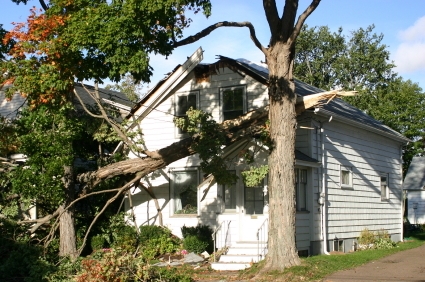High velocity and forceful wind brought about by hurricanes can rip off a significant portion of a roofing  system. It is believed that during such an event, wind gusts are considerably higher than the sustained velocity which causes the uplifting, suctioning, and twisting pressure that generates force sufficient enough to remove an entire roofing structure.
system. It is believed that during such an event, wind gusts are considerably higher than the sustained velocity which causes the uplifting, suctioning, and twisting pressure that generates force sufficient enough to remove an entire roofing structure.
A building must be able to withstand the cruel and destructive nature of hurricanes or tornadoes. It should have a good bracing structure from the building top to the external walls to the foundation in order to minimize the destructive effect of these strong blasts of air.
Choices
In some areas that are prone to hurricanes, tornadoes and other types of turbulent air currents, local governments impose certain building codes that require every building owner to utilize wind-resistant materials both for residential and commercial structures. These codes were created to adapt to the national and international codes designed for certain climatic condition locations.
In some places, materials are rated to withstand approximately sixty to ninety mph winds. Fortunately, new technology has produced products that exceed the ninety mph rating by providing even better resistance. High quality three-tab shingles are rated from ninety to one hundred ten mph; premium grade shingles are rated to one hundred thirty mph or higher; and metal can provide one hundred fifty mph or higher protection. Choosing these types of products will help to protect people and property from danger and discomfort; this is of course dependent upon the material being properly installed by a licensed contractor to obtain maximum performance.
Damage Prevention
Aside from utilizing high-quality wind-resistant products, there are several effective methods that can be done to reduce the effect of strong winds. This can be done through: proper nailing; installation of hurricane straps; and truss and gable-end bracing.
- Nailing – Most manufacturers recommend nailing pattern 1324; however, 1234 is also accepted. Avoid nailing on or above the self-sealing strip because it reduces the strength of the seal resulting in a lack of adhesion which can make the system more vulnerable to blow-offs. Do not use common nails because they easily rust and corrode. Be sure to follow the individual manufacturer’s instructions on proper nailing location. This will help avert moisture from getting into the system and aid in the prevention of premature failure. In addition, avoid high-angled, under-driven nails; nails should be installed flat on the shingles, not at an angle, and in the correct location.
- Hurricane Straps – Surviving the power of a strong air current with minimal damage starts with installing hurricane straps on the building top. One of the methods that can be used is to secure all the connections: roof-to-wall, floor-to-floor, and wall-to-foundation. To ensure that the system stays in place when strong winds blow; firmly fasten the top covering to the wall connection by installing the correct straps on every wall to the rafter connection. For existing construction, the best time to apply hurricane straps is during re-roofing. Along with a roof-to-wall connection, all the joints in the structures must be secured to create a continuous load path to transmit the load to the building’s foundation.
- Bracing – Adequate bracing on the gable-end is commonly overlooked. The gable-end should be braced at the top by attaching the roof sheathing correctly. Bracing will strengthen gable-ends by transmitting pressure onto all the truss members.
A roofing system is the primary structure most vulnerable to potential damage. High velocity wind has the inherent capacity for destruction and when it blows, that destructive nature is unstoppable. It can rip off the roof and wall sidings, uproot trees, and propel wind-borne missiles through the vulnerable side of a building. Damage could be extensive; however, there are techniques to limit any potential destruction. During turbulence, the direction of air current is directed from the roof to the walls and then to the foundation. Buildings can be secured by checking for areas of vulnerability, bracing gable-ends and trusses, installing hurricane straps, and choosing wind-resistant roofing products. Do not let strong wind destroy a roof; act now and prevent this from happening. The security and safety of all the building residents is at stake!
Call Schulte Roofing For Your Conroe Roofing Needs!
Have you been trying to find a Conroe roofing company to help you repair or replace your roof? Contact Schulte Roofing at 800-367-7663 for help with any of the roofing needs of Conroe area customers!
